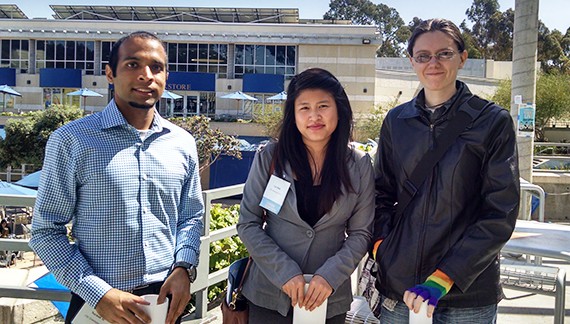
Three California State University, Dominguez Hills (CSUDH) chemistry students had the opportunity to not only present their own research, but view poster and verbal research presentations by their peers during the 33rd Annual Southern California Undergraduate Research Conference in Chemistry and Biochemistry (SCURCCB), held at the University of California, San Diego on April 11.
Hosted by the Southern California Section of the American Chemical Society (ACS), the conference attracted nearly 150 chemistry and biochemistry undergraduate researchers from more than 25 post-secondary institutions.
Noman Al, a junior studying chemistry at CSUDH, presented his poster “Estimation of Hydrophilic Lipophilic Balance of Gasoline Detergent Additives via Ethoxy Assay by GC-MS” at the conference.
The research Al presented was driven by his curiosity about the petroleum industry, a passion for organic chemistry, and a desire to become familiar with mass spectroscopy, a technique used to identify chemical compounds. A mass spectrometer was purchased with support from the W.M. Keck Foundation and its $200,000 grant to CSUDH for its unique cyber-enabled chemistry laboratory aimed at increasing diversity in the STEM fields by enabling students, especially those who work full- or part-time, to remotely access and analyze data outside the lab.
“Petroleum Chemistry is a lucrative field, with endless opportunities for research by young and emerging scientists,” said Al, a Redondo Beach resident. “In Southern California we are obviously very dependent on gasoline. Combining the practical aspect of gasoline with my interest in organic chemistry for a research project involving gasoline just made sense. Petroleum is a very precious commodity, and research to fully and efficiently utilize it should be a priority.”
Chevron’s gasoline additives, known as Techron, are designed to bind with and remove gunk that builds on the combustion chamber in vehicles’ engines, according to Al. His research seeks to characterize the Lipphilic Balance Hydrophilic (HLB) of the Techron molecule.
“The HLB value of a substance tells us its ability to solubilize certain substances, in this case, engine gunk and build-up,” said Al. “In order to make an accurate estimation of the value, I am subjecting the molecule to a variety of tests so I can determine the structure of the molecule. After knowing the HLB value, my goal is to modify it to get a value that should make the molecule more efficient at removing engine junk and build-up.”
Barbara Belmont, a lecturer in the Department of Chemistry and Biochemistry at CSUDH, said the free and local chemistry/biochemistry conference is “very real and accessible” for our students.
“The conference enables students to explain their research to and network with their undergraduate peers, and receive peer feedback about their research and ideas for further investigation,” said Belmont. “They also learn about research that other undergraduates are doing, which sets a high bar for continued achievement. It also helps them prepare for future presentations.”
Junior Lisa Dinh presented her research poster at the conference regarding the “Development of Copper(II) Ion Selective Electrode Membrane Using Luxol Fast Blue,” which she completed during fall 2014 semester. Junior Sidney Domholdt’s poster highlighted her ongoing research about the “Development of a Low Cost Cyclic Voltammetry Undergraduate Laboratory Experiment.”
The goal of both Domholdt’s and Dihn’s research is to develop affordable electrochemistry experiments for undergraduate analytical chemistry students.
All three CSUDH students’ research has been supported by the Society for Analytical Chemists of Pittsburgh’s grant for Undergraduate Analytical Chemistry Research.
“For two of the three students I took to the conference–Noman and Sidney–it was their very first time at any research conference,” said Belmont. “This in itself was an awesome experience. Lisa, the only repeat student, liked it so much last year that she was excited to have an opportunity to present her more recent research this year.”
Belmont, who introduced Al to mass spectrometry, a technique used to identify compounds based on their mass, has had a profound impact on his research and drive to progress in the field of chemistry.
“While working under Professor Belmont I have learned a great deal about different identification techniques of compounds,” said Al. “She has also shown me that if I want to achieve something that it is possible provided I put in the effort. Professor Belmont made me realize my potential as an organic chemist, and she is one of the primary reasons I decided to enroll in a Ph.D. program right after graduation. She is very an amicable person, with a heart bigger than life itself.”